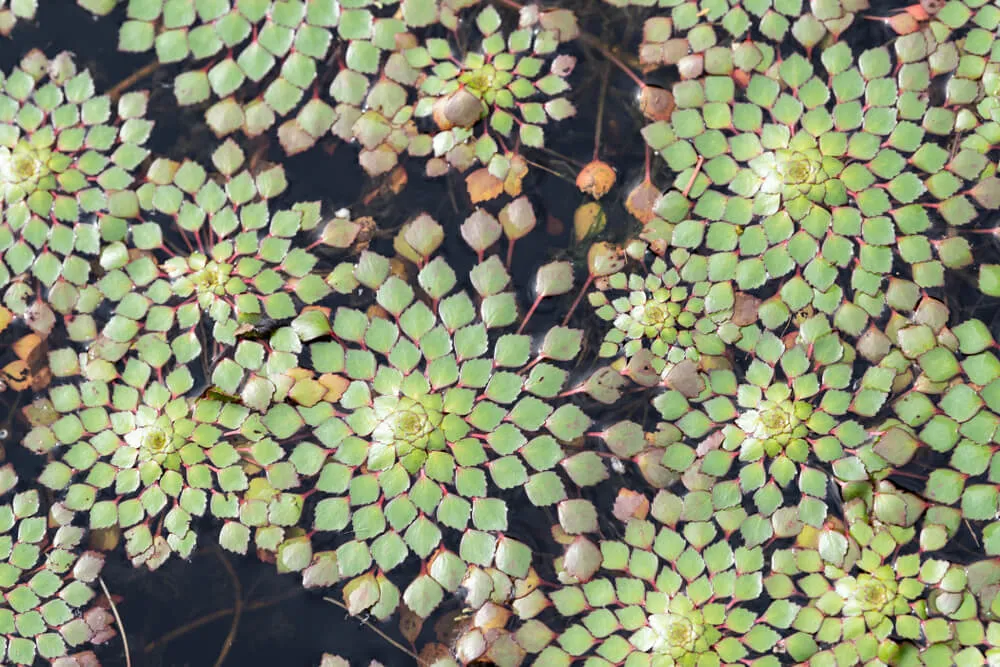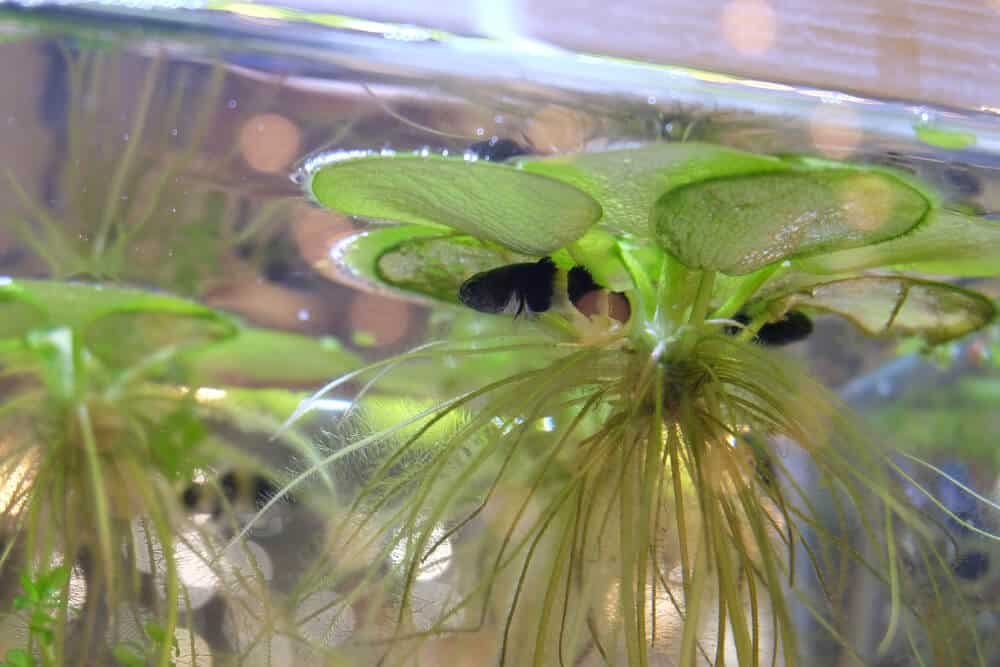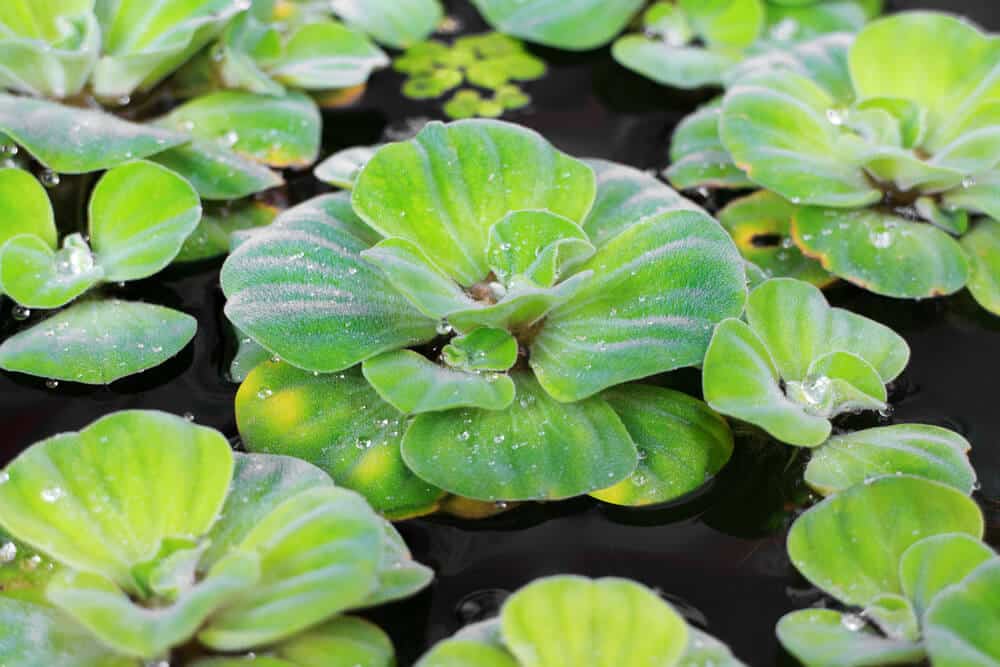Have you ever been curious about what a water sprite aquarium plant is? This plant is simply one of the most utilized plants in the aquarium industry.
It’s a floating aquatic fern that is prized for its rich green color, ease of care, and low maintenance.
It’s a flexible plant that can be cultivated submerged or emersed, rooted in the substrate, or floating in the water column. To develop properly, the plant demands moderate illumination, and it adds to the elegance and aesthetics of any aquarium setting.
Among the most frequent aquarium plants is the Water Sprite. Because its leaves mimic fern leaves, it is marketed under a variety of names, including Indian Fern and Water Fern.
If kept healthy, the plant is easy to care for and can withstand most freshwater aquarium environments. They provide your aquarium with lots of good shade. It gives your timid fish a hiding place when they’re frightened.
Freshwater ecosystems will appreciate the shelter these plants give; for some species of fish, this is also an excellent location to deposit eggs.
A Water Sprite is a typical freshwater aquarium plant that can be found practically everywhere, including pet shops and chain stores.
By reading this article, you can learn more about planting, nurturing, and propagating this plant.
The Water Sprite’s Origin And Habitat
Ceratopteris thalictroides are found in tropical climates on practically every continent. The water sprite is a formidable, adaptable creature that can live and thrive in a variety of environments.
In tropical climates, the plant can be found primarily in marshy areas. They can also be found in swamp woods, irrigation ditches, taro patches, irrigation ponds, rice paddies, marshes, and still and slow-flowing water bodies.
Ceratopteris thalictroides is a seasonal species, reaching maturity and spore production during the dry season. Water sprite, unlike other ferns, can grow in both bright and somewhat shady areas of water.
How Big Can A Water Sprite Get?
The leaves of the plant are green, but the stem is frequently a darker green than the leaves. The leaves emerge in a finger-like design from a central stalk.
If allowed to float in the right conditions, this plant can grow into a complex knot of stems, leaves, and roots. They usually reach a length of slightly over one foot.
The leaves mimic their land counterparts and resemble a regular fern. They stretch out from the stem and combine as the plant gets bigger, creating intriguing designs.
The plant will grow out of the aquarium if given enough room. They also have long roots that can be used as anchors in the ground or can float freely.
Check to see if your plant has long roots; this suggests that it is healthy.
Another factor to consider while purchasing Water Sprite is its hue. Any color other than green for the leaves and stem could indicate that something is wrong. Something is amiss with the plant or the aquarium conditions if the color is yellow or brown.
How Do You Plant A Water Sprite?
Begin with 2 – 3 inches of the substrate before planting your Water Sprite. It could be sand or gravel.
Put your plant into a tiny hole dug in the gravel. Bury the roots entirely and the base of the stem only slightly; it should be barely visible.
Because of how resilient this plant is, you may use almost any substrate. However, live aquarium plants should be kept in nutrient-rich plant substrate rather than aquarium sand.
This plant looks great in the middle to the back of your aquarium. Just make sure you’re not putting it near a direct water source, as this can harm the leaves.
Pruning And Trimming
Trimming is crucial! It’s difficult to keep up with the water sprite’s quick development process, but it’s necessary if you want to avoid aggressive growth patterns.
It’s a straightforward procedure if you know how to cut water sprite. All you have to do using trimming scissors is trim the superfluous growth.
Do not pull on the plant’s stem or leaves. To make a clean trim, always use scissors or shears. Otherwise, you run the risk of damaging the plant’s healthy portions that you’d like to maintain.
When pruning, pay special attention to fading leaves and exterior stems. To manage the general structure of the plant, trim the secondary stems. But stay away from the main center stem. Removing the main stem may result in the plant’s death.
The water sprite will need to be trimmed regularly. To avoid overgrowth, most aquarists cut their plants every few weeks.

Tank Companions
Most calm fish and invertebrates get along well with water sprite plants. The fragile leaves are ideal for smaller species of fish since they are soft enough for them to pass through without injury.
Water sprites are also used by livebearing fish such as mollies, guppies, and platies. Most aquarists employ them to keep fry secure from ravenous mouths in breeding aquariums.
This plant is loved by shrimps as well, and they are frequently seen rummaging through the leaves for food scraps. They also enjoy moving through the roots of dangling plants.
The Situation In The Tank
Once you’ve bought your plant, you’ll have to ensure it’s in the appropriate water for it to flourish.
Water Sprites are found in swamps and marshes, although they will grow anywhere they can. They can be discovered in somewhat deep water due to their rapid growth.
Water movement is modest in the wild, which suits their delicate leaves wonderfully. They thrive in high-light environments and take advantage of this to overrun their competitors.
Keep your plants away from the direct flow of water in your tank to simulate their natural habitat. This is a sensitive plant, and the straight flow may harm it.
This plant, on the other hand, is resilient. It is capable of surviving most water conditions as long as it is healthy. The following are the optimal water parameters:
| Temperature: | 68 – 82 °F |
| pH: | 6.0 – 7.5 |
| Hardness Range: | 3 to 8 on the KH scale |
| Luminosity Range: | Medium to High |
| Water Movement: | Low to Moderate |
Ensure you check your plant every time you replace the water in your aquarium to guarantee you have a healthy plant. There should be no damages to the leaves, and they should be a lovely shade of green.
Also, if at all possible, inspect the roots to ensure that they are long and plentiful.
Care And Maintenance
Water Sprite requires little maintenance. The size will be the most essential factor to consider.
It’s vital to clip some of the outer stems if it’s taking up too much room. Make sure you don’t cut the main stem (the one that protrudes directly from the roots) since this could injure the plant and possibly kill it.
Bare in mind that you should take the stems you cut from the aquarium. They will begin to produce roots and develop into a new plant if this is not done.
These plants will need nourishment to keep up with their rapid growth. They may even create nutrient deficit when first planted since they absorb so much nitrogen, phosphate, and potassium.
Add vitamins to avoid this. There are powder and liquid variants available, and both will work perfectly. Just make sure not to overdo it either.
Lighting
Water sprite plants need a medium quantity of light to thrive. Most of the time, ordinary tank illumination will suffice. However, the amount of light the plant receives will have a significant effect on its growth rate.
Submerging the plant in a deeper aquarium will make it more difficult for it to reach the light. As a result, your growth may be slowed slightly.
Floating water sprites are on the other end of the spectrum. Because floating plants are only a few inches from the light, their leaves expand to accommodate all of the rays.
Should You Float Water Sprites Or Plant Them?
Planting Water Sprites or allowing them to float is an option. Each of these cultivation techniques has its own set of benefits.
Floating plants offer a lot of color to the surface of your tank and, because they are nearer to the light, they have bigger leaves.
As they must absorb nutrients from the water, their roots will develop long, thin, and fine; these roots provide an excellent spot for shrimp and other critters to shelter and eat. It’s also the best environment for timid fishes since it also helps them hide.
One of the benefits of a floating plant is its capacity to provide shade. Many water plants require shade to thrive, and it also serves to maintain algae levels low.
Consider adding these plants to your aquarium if you’re having trouble with algae in your aquarium or if you’re experiencing an algae bloom.
Planting these plants is another option for keeping them in your aquarium. Planting them allows you to control the exact positioning of the plant, whereas floating plants do not.
Ensure your plant has adequate area to develop and won’t be overcrowded when determining where to place it.
Consider what you’re trying to accomplish before deciding whether to plant or float. Floating your plant adds style and movement to your aquarium while also providing shade for other plants.
Plant it, though, if you’re trying to fill a particular location in your aquarium or want a specific image for your plant.

Propagation Of Water Sprites
In the proper conditions, water sprites will grow swiftly.
They mostly reproduce by accidental shootings. It indicates that the plant will produce tiny plantlets that will eventually split off. These plants that split off will be able to plant themselves in the substrate or water column without assistance and will develop rapidly.
This is advantageous biologically since it permits a single parent to produce many offspring in a nutrient-rich environment. Overcrowding, though, can make this an issue.
If you don’t want your plant to propagate, be sure to wipe the plantlets.
Water Sprites can reproduce in two ways. If enough leaves are removed from a section of the stem, it can begin to produce roots and develop into a functioning plant.
To make a distinct plant, ensure the cuttings are a few inches long and have plenty of leaves. If you only have one huge plant in your aquarium, this is a good approach to introduce more.
If you want to proliferate, the first thing you should consider is how much room you have in your aquarium. Water Sprite grows quickly, and having numerous plants growing at the same time will take up not only the room but also resources.
There are just so many resources in your aquarium, like food and carbon dioxide. Overcrowding will be felt more slowly in larger tanks, but it will occur.
As a result, it’s critical to eliminate extra plants. You also need to ensure the water has enough nitrogen.
If you wish to add nitrogen to your aquarium, be sure it’s set up to handle it. If you add too much, bacteria will grow, and your plants will become sick.
Water Sprite Planting In Gravel Or Substrate
If you’re growing a water sprite, make sure the roots have at least 2 – 3 inches of gravel or substrate. In the substrate, make a small depression. At the crown of the plant, gently grasp it.
Carefully place the plant in the indentation, taking care not to damage the roots or stems. Place the substrate back into the indentation when the roots are secured to hold the plant in position.
Ascertain that the plant crown is visible to the naked eye and is level with the substrate’s surface. Water Sprite should not be planted with its crown too high, and its roots revealed.
Also, avoid planting the crown too deep, as this will result in the crown becoming covered.
Lastly, while Water Sprite can thrive on either substrate or gravel, live aquarium plants should be kept in nutrient-rich plant substrate rather than aquarium gravel.
Background vs. Midground Positioning
If you’re going to use Water Sprite as a backdrop plant, keep it away from the water intakes of your power filtration. The filter intake apertures may be swallowed up by the extremely fine stems and leaves.
It’s possible that the plant leaves could be harmed, or that the filter input will become blocked, or both. As a result, keeping a sponge pre-filter on the water intake may be a smart option.
If you’re going to use Water Sprite as a midground plant, make sure you give it plenty of areas to flourish. The plant stems will grow up toward the water’s surface in general.
The plant leaves, on the other hand, will occupy more lateral space in the tank as the stems expand. It’s not a major issue, but it’s worth noting for the sake of planning for the future.
Water Sprite can also be used as a foreground plant to create a low bushy shrub impression near the front of the aquarium, which some enthusiasts like.
Rather than just allowing stems with leaves to drop off the mother plant, position them in the foreground an inch or so away.
They should take root quickly and develop a light green leafy hedge.

Creating A Shaded Environment
Hobbyists can also use Floating Water Sprite to create shaded regions in their tanks. Because the floating leaves are so near to the source of light, they will block some light from reaching the tank’s base.
As a result, a floating plant can give shade to other plants that require less light.
Enthusiasts who prefer low-light plants with slow-growing leaves, such as Anubias Barteri, will appreciate this cover. When the light is direct and bright, algal accumulation can happen because Anubias Barteri leaves grow slowly.
Anubias Barteri, on the other hand, can develop without much algae growth if it is protected by floating Water Sprite.
The floating Water Sprite’s epiphyte-like features are another intriguing feature. Water Sprite roots can find stability by enveloping themselves around with other tough stemmed plants, such as floating or planted Anacharis.
The plant’s roots can also connect themselves to porous surfaces, such as Lava Rock, when they are floating.
Fertilizer And CO2 Dosing
With doses of aquatic plant fertilizer and CO2 addition, the development rate of water sprites can be enhanced.
When you have a large tank with a lot of plants, add nutrients to help the plants get more nitrogen. However, given the available nitrogen, the normal water sprite growth rate is adequate in a tiny aquarium with few plants.
If you have to medicate aquatic plants, ensure your aquarium is prepared to handle the extra nutrients. If you apply too much, bacteria will grow and may harm your plants.
Do Fish Eat Water Sprite?
Many fish species are compatible with a water sprite, though many of the bigger species prefer to feed on the plant’s delicate leaves.
Goldfish and bigger cichlids will quickly reduce this plant to a stub, though cichlids will disregard it when used as a floating plant, as they do with several plants.
Is Water Sprite Low Light?
Water sprite grows best in moderate to high light levels, although it will still grow in low light – but at a considerably slower rate. In a tank with a water sprite, it’s always advisable to use a full-spectrum light, and algae growth is rarely an issue.
What Is The Difference Between Water Wisteria And Water Sprite?
When it thrives above water, Water Wisteria is a flowering plant. But Water Sprite is an aquatic fern that does not generate flowers. When contrasted to Wisteria’s narrower leaves, Water Sprite is much bushier.
Wisteria can modify the structure of its leaves, but Water Sprite does not. It also has a central growing point or rhizomes, whereas Wisteria has well-defined stems and roots.
Plant Reproduction In Water Sprites
Water Sprites multiply swiftly by creating adventitious plantlets that swarm away from the parent plant. When they are ready, these plantlets will develop root systems and break away from the mother plant, allowing them to thrive on their own.
Another approach to duplicate these plants is to take a clipped stem with a healthy amount of leaves and place it back into the water. The cut stems should start sprouting roots and live as a new floating plant in a few days.
The Advantages Of Having Water Sprites In Your Aquarium
There are numerous benefits to owning a water sprite plant.
Like any living plant species, it can have a positive effect on water quality. To flourish, the roots draw nutrients from the water. Phosphorus and nitrogen, 2 of those nutrients, are commonly found in food and animal waste.
While many people consider aquarium plants to be nothing more than decoration, they can play an important role in ecology.
Another noteworthy advantage is the plant’s capacity to prevent algal blooms. As the plant grows, it will cast shadows across the entire aquarium. The restricted exposure to light deprives algae’s energy reserves, preventing large, unattractive blooms.
Lastly, having water sprite plants nearby will be beneficial to your fish. The plant can provide protection and concealment for timid fish. It will be used by even more rowdy fish, who will speed through the delicate leaves in a frenzy of fun.
Bottom Line
One of the most common mistakes people make is not putting plants in their aquarium. A priority should be given to water sprites or other plants.
These are not only lovely additions to your aquarium, but they also contribute significantly to the health of your fishes. These plants will do all you need them to accomplish, from cleaning the water to providing shade to creating homes and hiding spaces for timid fish.
They are incredibly hardy and have a rapid growth rate. Water Sprites are not only easy to take care of, but they are also low-maintenance.






